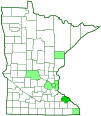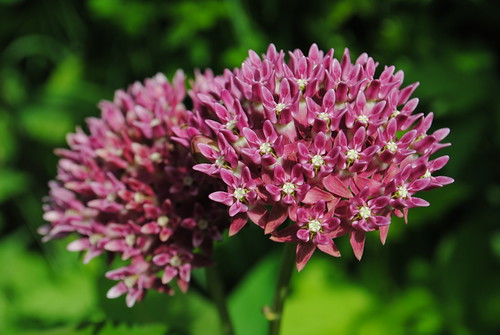purple milkweed
(Asclepias purpurascens)
Conservation • Wetland • Description • Habitat • Ecology • Use • Distribution • Taxonomy
Conservation Status |
|
|||||||
| IUCN Red List | not listed |
|||||||
| NatureServe | NNR - Unranked SH - Possibly Extirpated |
|||||||
| Minnesota | not listed |
|||||||
Wetland Indicator Status |
||||||||
| Great Plains | FACU - Facultative upland |
|||||||
| Midwest | FACU - Facultative upland |
|||||||
| Northcentral & Northeast | FACU - Facultative upland |
|||||||
Description |
||
Purple milkweed is an erect, perennial forb. A single stem rises from a fleshy taproot and short rhizomes. It often grows in clumps. The leaves and stems contain a milky juice. The stems are erect, stout, and unbranched. They are covered with short, fine, soft hairs. The leaves are opposite, untoothed, 4″ to 6″ long, up to 3″ wide, and elliptical or oblong. They have pointed tips and rounded bases that taper abruptly with concave sides to the stem. They are attached to the stem on ⅓″ to ⅝″ long leaf stalks. The upper surface is dark green and hairless, the lower surface light green and downy. The midvein often has a purplish tinge. The margins often curl upward. The inflorescence is 1 to 6 dense, umbrella-shaped clusters (umbels) near the top of the stem. The clusters are 3″ to 4″ in diameter and erect on a 2″ long stalk. They typically have up to 50 flowers. The structure of the typical milkweed flower is unique and instantly recognizable. There are 5 petals bent backward at the base and hanging downward. Subtending the petals are 5 much shorter, light green, lance-shaped sepals. There are 5 stamens. Formed from the filament of each stamen is a petal-like appendage. The appendage consists of a tubular hood surrounding an awl-shaped horn in the center of the hood. The stamens and the stigma are fused together into a crown-like structure (gynostegium). Each stigma has a long slit designed to catch the legs of a pollinating insect. A small, dark, sticky gland above this slit is attached to pollen sacs from adjacent anthers. These glands are designed to break off as an insect pulls its leg free of the slit, and remain attached to the insects leg. The flowers are pollinated by larger insects strong enough to lift off with the pollen sacs attached. Smaller insects are caught in a death trap or leave behind their detached legs. The flowers of this plant are shaped like the typical milkweed flower and are fragrant. They are ½″ to ⅔″ tall and about ¼″ wide. The petals are mostly purple but white at the base. They bend backward at the base, hang downward, then curl upward near the tip. They are attached directly below the hoods without a separating column. The horns are much shorter than the hoods. They project from the hoods and are curved inwards. The reproductive column in the center is white at the top. The fruit is a narrow, spindle-shaped pod. It is up to 6″ long and 1″ wide, and is covered with downy hairs. It is held erect on an erect stalk. It opens on one side exposing the seeds to spreading by the wind. The seeds have a tuft of white, silky hairs at the tip. |
||
Height |
||
18″ to 36″ |
||
Flower Color |
||
Purple |
||
Similar Species |
||
Common milkweed (Asclepias syriaca)leaves are softly hair on the upper surface. The umbels are drooping, appear in the upper leaf axils, and have up to 130 flowers. The flowers are a paler shade of purple or pink. The fruits are fat and are covered with warts. Swamp milkweed (Asclepias incarnata var. incarnata) stems are usually branched above the middle, and are hairless except for a vertical line of hairs on each side between the leaf nodes on the upper half. The leaves are narrower, lance-shaped to oblong tapering gradually to a sharp tip, and hairless on the underside. The horns are much taller than the hoods. It is usually found in wet areas. |
||
Habitat |
||
Wet to moist. Open swamps, marshes, streambanks, ditches, wet prairies, wet fields, meadows. Full sun. |
||
Ecology |
||
Flowering |
||
June to August |
||
Faunal Associations |
||
Milkweeds are the only plants that Monarchs lay their eggs on. The eggs are laid on the underside of healthy young leaves. |
||
Toxicity |
||
This and other milkweeds contain cardiac glycosides and may be poisonous to both humans and livestock. |
||
Pests and Diseases |
||
|
||
Use |
||
|
||
Distribution |
||||
|
Sources The only confirmed record of this plant in Minnesota (dark green on the map) is from Lake City in July 1883. The record in Carlton County (light green) is a preserved specimen in the H. A. Stephens Herbarium at Emporia State University in Emporia, Kansas. The remaining records (light green) are photographs submitted to and identified by computer at Pl@ntNet, then reported by GBIF. |
|||
| 5/31/2023 | ||||
Nativity |
||||
Native |
||||
Occurrence |
||||
Presumed extirpated |
||||
Taxonomy |
|||
| Kingdom | Plantae (Plants) | ||
| Subkingdom | Pteridobiotina | ||
| Phylum | Tracheophyta (Vascular Plants) | ||
| Class | Magnoliopsida (Dicots) | ||
Order |
Gentianales (Gentians, Dogbanes, Madders, and Allies) | ||
Family |
Apocynaceae (dogbane) | ||
| Subfamily | Asclepiadoideae (milkweeds) | ||
| Tribe | Asclepiadeae | ||
| Subtribe | Asclepiadinae | ||
Genus |
Asclepias (milkweeds) | ||
Subordinate Taxa |
|||
|
|||
Synonyms |
|||
Asclepias amoena Asclepias compressa Asclepias dasypus Asclepias gonalis Asclepias lasiotis |
|||
Common Names |
|||
purple milkweed |
|||
Glossary
Axil
The upper angle where the leaf stalk meets the stem.
Gynostegium
A crown-like structure of plants of the genus Asclepias formed by the fusion of the anthers with the stigmas.
Linear
Long, straight, and narrow, with more or less parallel sides, like a blade of grass.
Rhizome
A horizontal, usually underground stem. It serves as a reproductive structure, producing roots below and shoots above at the nodes.
Umbel
A flat-topped or convex, umbrella-shaped cluster of flowers or buds arising from more or less a single point.
Visitor Photos |
|||||
Share your photo of this plant. |
|||||
| This button not working for you? Simply email us at info@MinnesotaSeasons.com. Attach one or more photos and, if you like, a caption. |
|||||
|
|||||
MinnesotaSeasons.com Photos |
|||||
|
|||||

Visitor Videos |
|||
Share your video of this plant. |
|||
| This button not working for you? Simply email us at info@MinnesotaSeasons.com. Attach a video, a YouTube link, or a cloud storage link. |
|||
Other Videos |
|||
| Great-spangled fritillary nectaring on purple milkweed July 9, 2010 DSCN9935.AVI Aubrey Shepherd |
|||
About
Uploaded on Jan 11, 2011 Asclepias purpurascens, the purple milkweed, attracts a variety of butterflies and other pollinators on July 9, 2010, in Fayetteville, Arkansas. Video by Aubrey James Shepherd. |
|||

Visitor Sightings |
|||||
Report a sighting of this plant. |
|||||
| This button not working for you? Simply email us at info@MinnesotaSeasons.com. Be sure to include a location. |
|||||
|
|||||
MinnesotaSeasons.com Sightings |
|||||
|
|||||

|
Created: Last Updated: © MinnesotaSeasons.com. All rights reserved. |


